Is bad breath in dogs a sign of illness? The answer is usually “yes” unless you know your dog just ate something foul smelling. Integrative veterinarian Dr. Julie Buzby breaks down the science behind what causes halitosis (i.e. bad breath), what to do if your dog has stinky breath, and how to prevent bad breath.
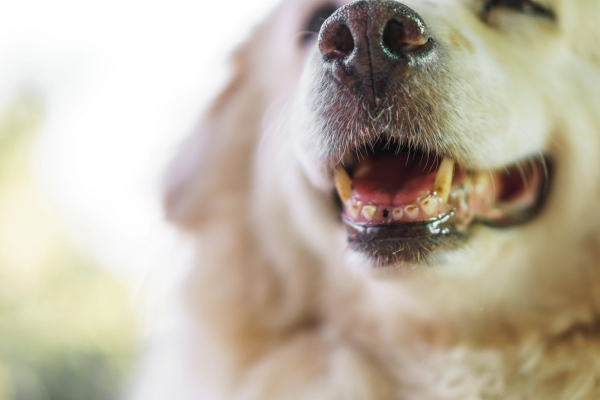
Dogs love their people. If they’re not licking our faces, they’re certainly breathing or panting right up close to us, making it hard to miss bad breath (i.e. halitosis). Brief bouts of bad breath may be blamed on a stinky snack. But consistent halitosis is usually a sign that something is wrong.
Which illnesses cause bad breath in dogs?
Bad breath is not an illness in and of itself, but it can be a symptom of certain health problems. Let’s take a look at some of the illnesses that may cause dog mouth odor.
Dental disease
If we want to find the underlying cause of stinky breath, it makes sense that the first place to check is inside the mouth. Dental disease in dogs (i.e. periodontal disease) is the most common cause of bad breath. Even if your dog’s teeth look healthy, bacteria in the mouth often live under the gumline, causing a malodorous infection.
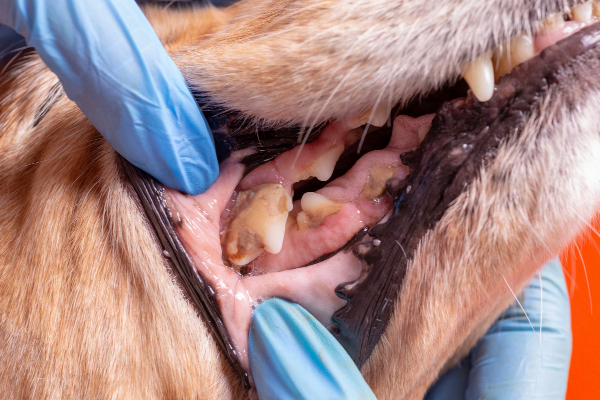
Foreign material in the mouth
In addition to dental disease, other issues inside the mouth can affect dogs’ breath. The foulest dog breath I have ever smelled came from a dog who had a small stick wedged in the roof of her mouth. The stick had been lodged between her premolars for at least two weeks! It eventually caused enough pain that the dog stopped eating, prompting her parents to bring her in for an exam.
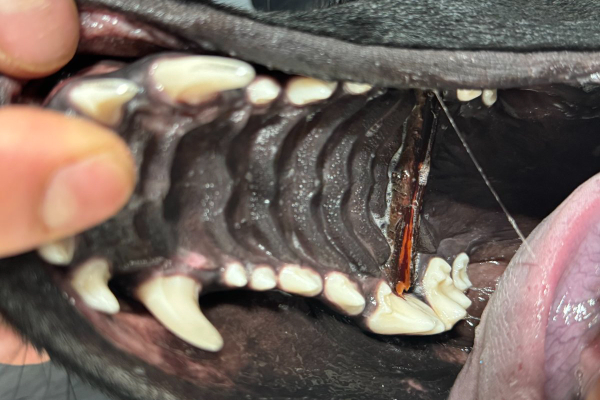
Oral tumors
Sometimes tumors grow in dogs’ mouths. They may be attached to the gums, lips, or tongue. If dog mouth cancer is in the back of the mouth, it can be really hard to see. Oral tumors may be benign or cancerous, but if they become ulcerated or infected, both types can cause smelly breath.
Kidney disease
Your dog’s kidneys act as filters, eliminating toxins and waste products through the urine. When kidney failure in dogs occurs, those waste products build up and are sometimes detectable on the breath. Dogs with advanced kidney disease have breath that smells like ammonia or urine, also called uremic breath. Other signs of kidney failure can include changes in appetite, increased thirst in dogs, and weight loss.
Liver disease
Similarly, the liver removes toxins from the body. If these toxins build up due to liver disease in dogs, it may cause a change in the way your dog’s breath smells. Dogs in liver failure can have such bad breath that it has been described as similar to rotten eggs, or even a dead animal.
If your dog suddenly develops very foul breath, especially if accompanied by other clinical signs such as yellowing of the skin or eyes, see your veterinarian right away.
Diabetes
Diabetes in dogs is another condition that can affect the way dog breath smells. If a diabetic dog is in diabetic ketoacidosis (DKA in dogs) and has high levels of ketones in the blood, his breath can smell sweet. (Interestingly, not all people can smell ketones.) Diabetic dogs may also exhibit increased thirst, increased urination, and weight loss.
Gastrointestinal problems
Dogs who are frequently vomiting or regurgitating (passively bringing up undigested food, as may occur with megaesophagus in dogs) may also have bad breath. Usually their breath smells like whatever it is they vomited or regurgitated.
Infections
Skin infections (pyoderma in dogs) can cause stinky breath if your dog licks his or her skin a lot. Plus, exhaled air that passes through infected sinuses or lungs (like in pneumonia in dogs) may smell bad too.
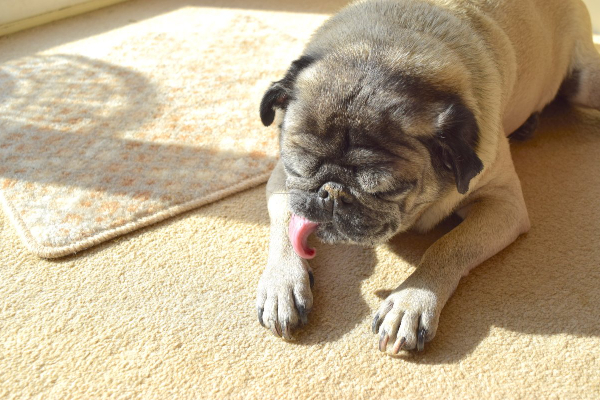
What should you do if you are worried an illness is causing your dog’s bad breath?
If your dog has bad breath and you are concerned he or she could be sick, the best thing to do is to make an appointment with your veterinarian. He or she will ask you some questions about your dog and carefully examine your dog from nose to tail.
Depending on your answers to the questions and the results of the examination, the vet may recommend further diagnostics such as blood tests for dogs to try to get to the bottom of the issue.
What is the treatment for bad breath in dogs?
Because bad breath in dogs is a sign of illness, not a disease itself, the only way to combat it is to treat the underlying condition. This is why seeing the veterinarian and allowing him or her to run the recommended tests is so important. Your vet can make specific treatment recommendations once he or she knows what’s causing your dog’s bad breath.
Treatment for dental disease
Unfortunately, you can’t brush your dog’s bad breath away. At-home tooth brushing can help remove plaque, but it will not remove hardened tartar or clean under the gumline. Once dental disease has progressed to the point of causing odorous breath, the only effective treatment is an anesthetized dental cleaning at the veterinary clinic.
Important note: An anesthesia-free dental cleaning by a non-veterinarian is NOT a substitute for a comprehensive oral health assessment and treatment with the veterinarian. Though I wish I could ask my patients to lay still and say “Ahh,” general anesthesia is essential to be able to perform a thorough dental exam and cleaning in dogs.
Treatment for other health conditions
If your dog’s smelly breath is stemming from a problem that is not within the mouth, the primary underlying health issue will need to be addressed. This may include medications such as insulin for diabetes. Or the vet may need to hospitalize your dog to treat serious illnesses like liver or kidney failure.
Can bad breath in dogs be prevented?
The number one culprit for bad breath in dogs is dental or gum disease. Thus, comprehensive oral hygiene is the best way to proactively combat it. At-home dental care for dogs can include:
- Brushing your dog’s teeth
- Dental treats such as those recommended by the Veterinary Oral Health Council (VOHC)
- Dental chew toys (and making sure you choose safe chew toys for dogs)
- Prescription dental food for dogs
Important note: Make sure you are using pet-safe toothpaste. Using human toothpaste on dogs can make them very sick. Plus, toothpaste formulated for dogs usually comes in flavors that are appealing to them, such as poultry, beef, or even peanut butter. My favorite toothpaste for dogs is Virbac C.E.T. Enzymatic Toothpaste.
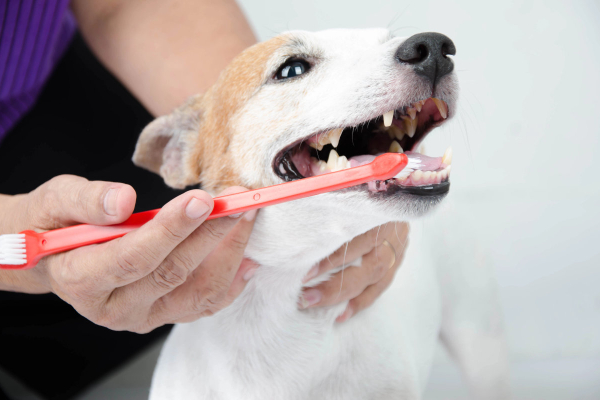
Dental cleanings for dogs
Just like people should visit the dentist routinely, dental cleanings play an important role in keeping dogs healthy and preventing bad breath. Your veterinarian can help you figure out if your dog is due for a dental.
As the saying goes, an ounce of prevention is worth a pound of cure. This holds true for canine dental care too. I know dentals can be expensive, and putting your dog under anesthesia can be worrisome. But staying ahead of your dog’s dental health will save you both a lot of grief. Putting off dental cleanings for too long can lead to teeth that are too diseased to leave in. At that point, the best course of action is usually dog tooth extractions.
Yes, bad breath in dogs is a sign of illness
If you notice a change in the way your dog’s breath smells, it’s best to take him or her to your veterinarian. The sooner you can discover the underlying reason, the easier it may be to resolve. Addressing bad breath helps keep your dog healthy and comfortable. And it also means you can snuggle up together without having to hold your nose!
Was your dog’s bad breath a sign of illness?
Please comment below.


We welcome your comments and questions about senior dog care.
However, if you need medical advice, diagnosis, or treatment, please contact your local veterinarian.